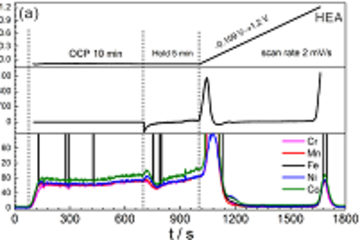All genres
1.
Journal Article
Reducing Iron Oxide with Ammonia: A Sustainable Path to Green Steel. Advanced Science 10 (16), 2300111 (2023)
2.
Journal Article
Laser-equipped gas reaction chamber for probing environmentally sensitive materials at near atomic scale. PLoS One 17 (2), e0262543 (2022)
3.
Journal Article
Hydrogen-based direct reduction of iron oxide at 700°C: Heterogeneity at pellet and microstructure scales. International Journal of Minerals, Metallurgy and Materials 29 (10), pp. 1901 - 1907 (2022)
4.
Journal Article
Influence of Microstructure and Atomic-Scale Chemistry on Iron Ore Reduction with Hydrogen at 700°C. Acta Materialia 212, 116933 (2021)
5.
Journal Article
Influence of Al content and pre-oxidation on the aqueous corrosion resistance of binary Fe–Al alloys in sulphuric acid. Corrosion Science 149, pp. 123 - 132 (2019)
6.
Journal Article
The Laplace project: An integrated suite for preparing and transferring atom probe samples under cryogenic and UHV conditions. PLoS One 13 (12), e0209211 (2018)
7.
Journal Article
Electrochemistry in ultra-high vacuum: The fully transferrable ultra-high vacuum compatible electrochemical cell. Review of Scientific Instruments 89 (11), 113102 (2018)
8.
Journal Article
The Origin of the Catalytic Activity of a Metal Hydride in CO2 Reduction. Angewandte Chemie International Edition 55 (20), pp. 6028 - 6032 (2016)
9.
Journal Article
Direct In-Situ Investigation of Selective Surface Oxidation During Recrystallization Annealing of a Binary Model Alloy. Oxidation of Metals 85 (1-2), pp. 51 - 63 (2016)
10.
Journal Article
Ultra high vacuum high precision low background setup with temperature control for thermal desorption mass spectroscopy (TDA-MS) of hydrogen in metals. Talanta 136, pp. 108 - 113 (2015)
11.
Journal Article
Chemistry-dependent X-ray-induced surface charging. Physical Chemistry Chemical Physics 16 (40), pp. 22255 - 22261 (2014)
12.
Journal Article
Early stages of oxidation observed by in situ thermogravimetry in low pressure atmospheres. Corrosion Science 86, pp. 183 - 188 (2014)
13.
Journal Article
A novel laboratory set-up for investigating surface and interface reactions during short term annealing cycles at high temperatures. Review of Scientific Instruments 84, 085108 (2013)
14.
Journal Article
Structure and volta potential of lipid multilayers: Effect of X-ray irradiation. Langmuir 29 (2), pp. 815 - 824 (2013)
15.
Journal Article
A scanning Kelvin probe for synchrotron investigations: The in situ detection of radiation-induced potential changes. Journal of Synchrotron Radiation 19 (1), pp. 48 - 53 (2012)
16.
Journal Article
Corrosion behaviour of Fe–Al(–Ti) alloys in steam. Intermetallics 18 (7), pp. 1375 - 1378 (2010)
17.
Journal Article
Nitridation in NH3–H2O Mixtures. Material and Corrosion 54 (11), pp. 895 - 901 (2003)
18.
Book Chapter
Investigations of the delamination of polymer-coated zink and steel surfaces with the scanning Kelvin probe in a climatic cycle test. In: In: Technical Steel Research, EUR 20348 EN, pp. 1 - 198 (Ed. Steel Research). Steel Research, Brussels, Belgium (2002)
19.
Conference Paper
Influence of the Al content on the aqueous corrosion resistance of binary Fe–Al alloys in H2SO4. In: Proc. Intermetallics 2017. Intermetallics 2017, Educational Center Kloster Banz, Bad Staffelstein, Germany, October 02, 2017 - October 06, 2017. (2017)
20.
Conference Paper
XANES studies on Eu-doped fluorozirconate based glass ceramics. In: Materials Research Society Symposium Proceedings, pp. 137 - 144. Materials Research Society 2010, San Francisco, CA, USA, April 05, 2010 - April 09, 2010. (2010)










